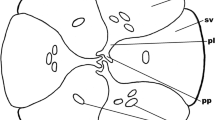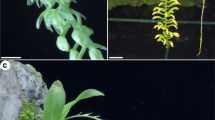Abstract
Observations of young leaf primordia give information about the origin of the fertile spike ofOphioglossum pedunculosum Desv. Each primordium shows a certain asymmetry that is visible in form and position of the fertile spike primordium, but above all in the course of the marginal meristem. The fertile spike primordium is connected with the marginal meristem on the right or that on the left side of the sterile segment. On the basis ot these observations the following concept of the origin of the fertile spike is formed: The marginal meristem curves on one side of the leaf primordium and turns towards the ventral side. This process is followed by meristem fractionation in the course of which the smaller part curved towards the middle of the leaf primordium becomes independent and initiates the development of the fertile spike, whereas the larger part of the marginal meristem contributes to the growth of the sterile segment.
Similar content being viewed by others
Literatur
Bierhorst, D. W., 1971: Morphology of Vascular Plants. — New York: Macmillan.
Bower, F. O., 1926: The Ferns. Vol. 2. — London: Cambridge University Press.
Campbell, D. H., 1907: Studies on theOphioglossaceae. — The American Naturalist41, No. 483, 139–159.
- 1911: TheEusporangiatae. — Carnegie Inst. Wash. Publ. No.141.
Chrysler, M. A., 1910: The Nature of the Fertile Spike in theOphioglossaceae. — Ann. of Bot.24, 1–18.
Foster, A. S., Gifford, E. M., 1974: Comparative Morphology of Vascular Plants. 2nd ed. — San Francisco: Freeman.
Gerlach, D., 1969: Botanische Mikrotechnik. — Stuttgart: DTV-Thieme.
Goebel, D., 1930: Organographie der Pflanzen. Bd. 2, 3. Aufl. — Jena: G. Fischer.
Hagemann, W., 1965: Vergleichende Untersuchungen zur Entwicklung des Farnsprosses II. Die Blattentwicklung in der GattungAdiantum L. — Beitr. Biol. Pflanzen41, 405–468.
Hagemann, W., 1970: Studien zur Entwicklungsgeschichte der Angiospermenblätter. Ein Beitrag zur Klärung ihres Gestaltungsprinzips. — Bot. Jb.90, 297–413.
Holle, H., 1875: Über Bau und Entwicklung der Vegetationsorgane der Ophioglossaceen. — Bot. Zeitung33, 241–322.
Johansen, D. A., 1940: Plant Microtechnique. — New York: McGraw Hill.
Roeper, J., 1859: Zur Systematik und Naturgeschichte derOphioglossaceae. — Bot. Zeitung17, 1 ff.
Troll, W., 1933: Über die Blattbildung der Ophioglossaceen, insbesondere vonOphioglossum. — Planta19, 547–573.
Troll, W., 1939: Vergleichende Morphologie der höheren Pflanzen1/2. — Berlin: Borntraeger.
Zimmermann, W., 1942: Die Phylogenie des Ophioglossaceen-Blattes. — Ber. Deut. Bot. Ges.60, 416–433.
Zimmermann, W., 1959: Die Phylogenie der Pflanzen. 2. Aufl. — Stuttgart: G. Fischer.
Author information
Authors and Affiliations
Rights and permissions
About this article
Cite this article
Decker-Eisel, C., Hagemann, W. Untersuchungen über den Ursprung der fertilen Fieder vonOphioglossum pedunculosum . Pl Syst Evol 130, 143–155 (1978). https://doi.org/10.1007/BF00983078
Received:
Issue Date:
DOI: https://doi.org/10.1007/BF00983078




